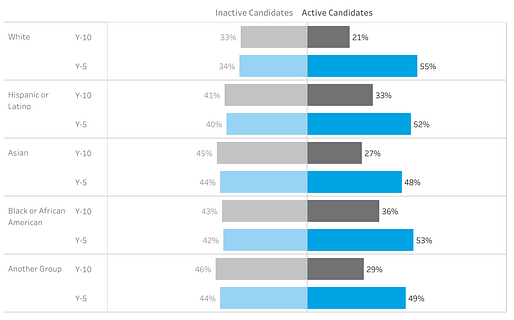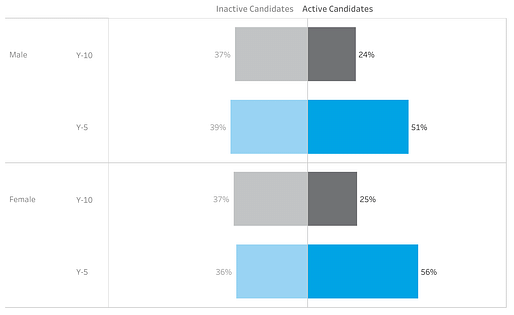
NCARB has released its twelfth annual data report, NCARB by the Numbers, highlighting key trends in architectural education and licensure.
The report, derived from NCARB’s database of over 128,000 licensure candidates and architects, shows a 9% rise in the number of architecture license candidates in 2022, exceeding 35,000. The average time from starting college to licensure was 13.3 years, with women achieving licensure about 11 months faster than men. New architects are also increasing diversity in the profession, with one in three new architects being a person of color and two out of five being women.

The report indicates that in 2022, there were nearly 120,000 licensed architects in the U.S. Licensed architects held about 145,000 reciprocal licenses, a 6% increase from the previous year, which NCARB explains as a demand for professional mobility due to COVID-19.
Despite the 9% increase in licensure candidates, there was a small decrease in the number who achieved licensure due to lower completion rates of the experience program and the impact of the pandemic. The total number of U.S. architects decreased by around 1%, which NCARB suggests is due to retirements not being offset by new architects.

NCARB data also show continuing disparities in the licensure process related to race, gender, and age. Over time, white candidates have consistently been the least likely to abandon the licensure path, although the disparity between racial and ethnic groups is narrowing. For candidates who started the path the licensure between 2008-2012, there was a 13% gap between white and Black or African American candidates, with the latter being more likely to discontinue the path. Of this 2008-2012 cohort, 43% of white and 18% of African American candidates are now licensed architects.
For those starting the path between 2013-2017, the gap reduced to 10%, with Asian candidates being the most likely to discontinue. Most candidates of all races stopped pursuing licensure while earning professional experience. Recently (2018-2022), 74-79% of all racial and ethnic groups remain active in their licensure journey. However, those identifying as Native American and Native Pacific Islander were most likely to discontinue at 27%, followed by African American and Asian candidates at 26%.

Between 2008-2012, women were more likely than men to discontinue the licensure path (45% vs. 41%). Of this group, 39% of men and 36% of women are now licensed architects. Between 2013-2017, attrition rates for men and women were nearly equal at 38% and 37%, respectively. In the most recent group (2018-2022), men were more likely to discontinue, while 75% of women compared to 71% of men remained active.

Younger candidates have been historically less likely to discontinue than those over 40. Between 2008-2012, candidates aged 40-54 were 11% more likely to discontinue than those aged 23-29. Between 2013-2017, the gap increased to 23% between candidates aged 55+ and 18-22. Recently (2018-2022), 70-81% of candidates of all ages remain active, although those aged 40-55+ were most likely to become inactive. Most candidates discontinued before starting NCARB programs.
20 Comments
Good greif! It's taking an average of 7 years to complete the supposedly "3-4year" AXP+ exam process!
First, the degree needed may take between 5-8 years to complete.
Let us also factor in that AXP is frequently taken after the degree because architectural employers just don't tend to hire students because they almost only want or hire full-time employees which makes it impossible to attend college (in most architecture schools) and work because of classes that requires attendance occurring between 8AM and 5PM... the same block of hours employees are expected to work or be available to work.
Additionally, when you do not have an NAAB-accredited degree, the minimum number of years you must get increases. This can be from 2 years to 15 years or about (minimum) but often, a person has to work more than the minimum number of years. Times laid off also factors. This must take into account those on alternative path to licensure in various states.
Many states requires the person to complete the education/experience before they even can begin the exams. This still exists and has some effect on the licensing path average.
If we want to be clear, we need to look at the average of those on regular track to licensing, those on IPAL, and those on state-based alternative paths, respectively. This comprehensive analysis, albeit more detailed, can get to seeing what's going on.
There are also places where you can't start ARE until you completed AXP and so forth. Additionally, the exam can take multiple years for some to pass the ARE exams including retakes. I think there is a number of factors involved. COVID also affected some and will be reflected in the duration to licensure in a number of candidates/licensees for the next decade or so.
13y AVERAGE?
Damn... ya'll are doing something wrong. 3y post m.arch is typical for us dirty communists up north.
I think it can be all summed up in 4 words "Fucking excessive student loans"
Wait... that's because Canadian years are longer, right?
What does student loans have to do with it?
no wonder there's been so much cheating, this system is broken
No shit einstein
it takes a lifetime...
The architecture profession is terrified of deregulation — because then we would see how much design is valued beyond cartels, inflationary bureaucracy and artificial scarcity.
Let design out of the cage.
Now can we talk about how shitty NCARB is to this profession, and cheating on exams is warranted?
Are you seriously suggesting cheating on the ARE exams?
If people cheat on the exams or there is no meaningful licensure exam component for licensing then why bother with architecture as a licensed profession?
Yes, I'm serious.
it probably doesn't need to be licensed. licensure is nothing but credentialism used to gate-keep, it's an economic tool. building codes and zoning ordinances are what keep people safe, not exams.
Then people can take voluntary certifications like the CPBD certification and others as voluntary credentials for economic, marketing, business purposes. I don't have a problem with it. Of course, people shouldn't cheat on those exams but I can support deregulating the profession of architecture in states where there are good and robust building codes and zoning regulations and adequate enforcement. However, there are weaknesses in the enforcement. I would support laws holding architects / building designers for negligence and such as architects now.
Throwing out some ideas here:
Holding any person who by occupation is to design buildings, who is responsible for the preparation of the technical submissions. Statutes that requires that the owner(s) of the architectural firm is required to be responsible for the oversight and review of the technical submissions where the employees may prepare them but under the responsible supervision and control. Of course, experienced individuals may be afforded more independence but anyone legally responsible for the services and the work produced in rendering those services shall be owner(s) not mere employees.
In which case, I can see the firms being registered and have an official seal for firms which only firm owners which would be listed as mandatory architects responsible for the architectural services regardless if they are a sole-proprietor, general partnership, or any other business type. Additional persons may be designated "Architects of Responsible Charge" of architectural services of the firm but those persons would have to sign to be listed.
Firm owners will mandatorily be listed but only be responsible if they sign, affix the firm stamp, and identified on the plans which would be required. Firm owners who did not sign or have anything to do with the project at all would not be responsible beyond standard liability exposure. The idea is the firm owner would have to have a nexus of responsibility for the project.
Non-firm owners would not be responsible unless they sign the form to be listed as additional "Architects of Responsible Charge", making it voluntary. Laws and rules can be made that prohibits requiring employees who do not have any ownership stake to be designated as "Architects of Responsible Charge" for the firm. Requiring that it be voluntary and that the firm owners, as the employer, shall not lay off or otherwise terminate the employment of employees who refuses and be grounds for disciplinary action of the firm and firm owners, and wrongful termination lawsuit.
This would be an idea for how to change the laws ending "individual" architect licensure but still have or to establish architectural firm registration.
I would still think there should still be some regulation. Perhaps, requiring businesses that provides architectural services be registered so we would still have a state board for registration and disciplinary actions.
Chances of happening is slim.
AXP is a bigger problem than the exam. Some people are spending years trying to honestly work the needed range of experience in the mass of categories that NCARB requires, while others get their licensed buddies sign off on bogus and inflated AXP reports. NCARB doesn't give a f*ck about any of it.
I would once say to deregulate all design professions. Instead I think we should deregulate the title acts, and allow plan stamping with review, or give licenses upon graduating/exam, and scrap the internships. Let there be plan check/stamp services . That seems like a more efficient system and would spare 90% of the professionals who never need to use their stamp anyways the long bureaucracy, while allowing a meaningful title that demands more pay and status out of the gates.
Just wait until chatGPT merges with a CAD and MidJourney ... It will know every code, rule and regulation in every region, county,state county that has been published. It will be attached to the most sophisticated mathematics (engineering) tools and be familiar with all the protocols of DA submissions. It will also created fantastic scheduling spreadsheets, costings and payment plans. Bring it on.
Designer: “AI will be able to handle all the codes, and tediously boring stuff freeing up time to design and make better places”. Code Expeditor named Rex: “No, but it will learn to kill us! It’s dangerous”
Imagine what Autodesk's monthly subscription price will be for the for the AI you describe!
Block this user
Are you sure you want to block this user and hide all related comments throughout the site?
Archinect
This is your first comment on Archinect. Your comment will be visible once approved.